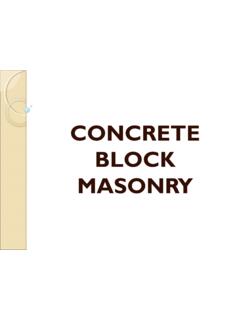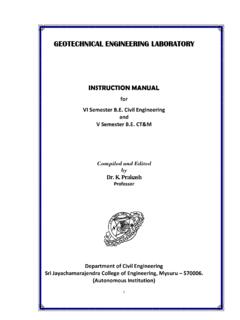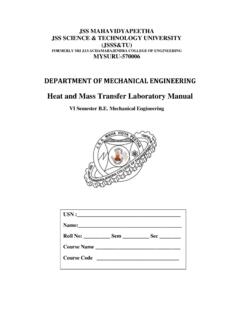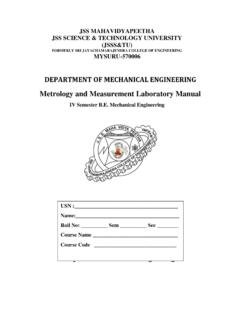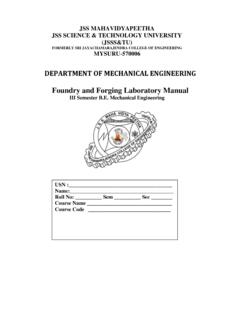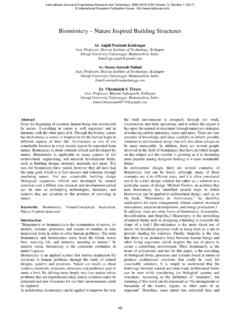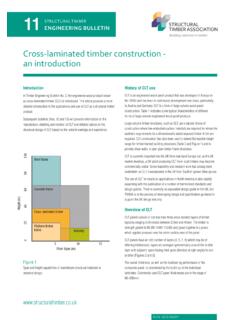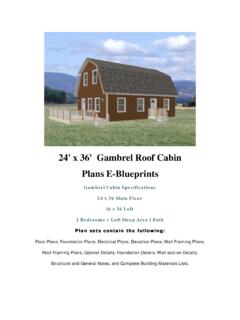Transcription of EARTHQUAKE RESISTANT DESIGN OF STRUCTURES
1 EARTHQUAKE RESISTANT DESIGN OF STRUCTURES 1Dr. G. P. ChandradharaProfessor of Civil EngineeringS. J. College of EngineeringMysore-570 006E mail : 094482 46425 Attenuation of Ground MotionSince peak acceleration is the most commonly used ground motion parameter, many peak acceleration attenuation relations have been relationshipIn PGA(g) = + M In [R + x e ]M Local magnitude in Richter scaleR Epicentral distance in km2 GROUND MOTION PARAMETERS3 GROUND MOTION PARAMETERSS everal EARTHQUAKE parameters are used to quantitatively describe the various characteristics of ground motion. PGA, PGV, content -Ground motion Spectra-Spectral Parameters3. Duration4 GROUND MOTION Ground Acceleration PGAPGA is a measure of maximum amplitude of motion and is defined as the largest absolute value of acceleration time history.
2 PGA is extensively used in engineering. Vertical PGA is 2/3 of horizontal PGA. Response of stiff structure is related to Velocity PGVPGV is the largest absolute value of Velocity time history. It is more sensitive to Intermediate frequency content of Displacement PGDPGD reflects the amplitude of lower frequency components in ground motion. Estimation of these is difficult as the errors in signal processing and numerical integration MOTION PARAMETERSPGA, PGV, PGD2. Frequency Content of ground motion is an amalgamation of harmonic motion with a range of frequency components and amplitude. Spectra7 GROUND MOTION PARAMETERSA response spectrum is simply a plot of the peak response (displacement, velocity or acceleration) of a number of SDOF systems of varying Natural period or Frequency, that are subjected to same base vibration.
3 The resulting plot can then be used to find the response of any structure , knowing its Natural Response Rock or Hard Soil Medium Soil Soft SoilSa/gTime Period (secs)Response Spectrum IS : 1893 :20022. Frequency Content of MotionAdvantages of Response Spectrum Responsespectrumhasfoundvitalimportancei nstructuralengineeringsinceitsinception( Housner,1941;Hudson,1956;NewmarkandHall, 1982).Responsespectrummethodofanalysisfi ndsadvantageduetofollowingreasons. Unlikepseudo-staticanalysisitconsidersth efrequencyeffects. Unlikethoroughdynamicanalysis,itprovides asinglesuitablehorizontalforceforthedesi gnofstructure. Theidealizationoftreatingthesystemasasin gledegreefreedomsystemisacceptableinstru cturalengineeringproblemswherethecomplex itiesinvolvedintermsofgeometry,materialp ropertyandboundaryconditionarerelatively less.
4 The response may be expressed in terms of acceleration, velocity or displacement. The maximum values of each of these parameters depend only on the natural period or frequency and damping ratio of the single degree of freedom system (SDOF). The maximum magnitudes of acceleration, velocity and displacement at different natural periods are referred to as the spectral acceleration (Sa),spectral velocity (Sv) and spectral displacement (Sd) respectively. A single degree of freedom system of zero natural period (infinite natural frequency) would be rigid, and its spectral acceleration would be equal to the peak ground acceleration. Response Spectrum Although PSV and PSA are not the true maximum values of velocity and acceleration, they are usually very close to maxima for the recorded ground maximum response motions and the spectral acceleration, velocity, and displacement can be approximately related to each other by the following simple expressions:Response Spectrum tu gut gEarthquake AccelerogramResponse of the StructureRESPONSE SPECTRUM CONSTRUCTIONFind umaxIt is a plot of the peak response (Velocity, Displacement or Acceleration) with respect to Period of SDOF system for a given base motion (Accelerogram.)
5 T gEarthquake AccelerogramConcept of Response Spectrum Find Response umax in each caseu2, maxu3, max g T1T2T3u1, maxTu, maxFor various values of Period of SDOF STRUCTURES , Find Peak Displacement for the given input EARTHQUAKE acceleration and plot Response v/s SpectraThe plot of Fourier amplitude or phase angle of input time history vs. Time period or Frequency is known as Fourier Spectra. The Fourier amplitude spectrum provides inputs on the frequency content of the motion and helps to identify the predominent frequency of motion. SpectraFrequency contents of ground motion can also be represented by a power spectrum or power spectral density function. of strong Motion Several definition have been proposed for the strong motion duration of an accelerogram.
6 Duration of strong motion as the interval in which 90% of the total contribution to the energy of the accelerogram. 14 GROUND MOTION PARAMETERSBUILDING CHARACTERISTICS15 Theseismicforcesexertedonabuildingarenot externallydevelopedforceslikewindinstead theyaretheresponseofcyclicmotionsattheba seofabuildingcausingaccelerationsandhenc einertiaforce Theresponseisthereforeessentiallydynamic innature Thedynamicpropertiesofthestructuresuchas naturalperiod,dampingandmodeshapeplayacr ucialroleindeterminingtheresponseofbuild ing Besides,othercharacteristicsofthebuildin gsystemalsoaffecttheseismicresponsesucha sductility,buildingfoundation, Characteristics Fundamentalmodesofthebuildingmaybedeterm inedbyanyoneofseveralmethodsdevelopedfor thedynamicanalysisofstructures Onthebasisoftimeperiod.
7 Buildingmaybeclassifiedasrigid(T< ),semi rigid( <T< )andflexiblestructure(T> ) Buildingswithhighernaturalfrequencies,an dashortnaturalperiod,tendtosufferhighera ccelerationsbutsmallerdisplacement Inthecaseofbuildingswithlowernaturalfreq uencies,andalongnaturalperiod,thisisreve rsed:thebuildingswillexperienceloweracce lerationsbutlargerdisplacements17 Building case of structural system very flexible, it has low natural frequency, The motion practically is not transmitted to the mass and the massRemains more or less stationery in space. Thus the relative displacement of the mass ground will tend to beequal to the ground case structural system very stiff or rigid having a very high natural frequency, the motion of the mass is approximately the same as that of the ground and the absolute acceleration of the mass will tend to be equal to the found accelerationBehavior of Flexible and Rigid Inertialforcesgeneratedinthebuildingdepe nduponthefrequenciesofthegroundonwhichth ebuildingisstandingandthebuilding'snatur alfrequency Whenthesearenearorequaltooneanother,theb uilding'sresponsereachesapeaklevel Paststudiesshowthatthe ( )willhavemoreunfavorableseismicresponset hanflexiblestructures, (t> )
8 (where,Nisthenumberofstorey),19 Building CharacteristicsOnthebasisoftimeperiod,bu ildingmaybeclassifiedasrigid(T< ),semi rigid( <T< )andflexiblestructure(T> ) Thedegreeofstructuralamplificationoftheg roundmotionatthebaseofthebuildingislimit edbystructuraldamping Dampingistheabilityofthestructuralsystem todissipatetheenergyoftheearthquakegroun dshaking Sincethebuildingresponseininverselypropo rtionaltodamping,themoredampinginabuildi ngpossesses,thesooneritwillstopvibrating --whichofcourseishighlydesirablefromthes tandpointofearthquakeperformance Inastructure,dampingisduetointernalfrict ionandtheabsorptionofenergybythebuilding 'sstructuralandnonstructuralelements Ductilityisdefinedasthecapacityofthebuil dingmaterials,systems.
9 Orstructurestoabsorbenergybydeformingint heinelasticrange Thesafetyofbuildingfromcollapseisontheba sisofenergy,whichmustbeimpartedtothestru ctureinordertomakeitfail Insuchinstance,considerationmustbegivent ostructure scapacitytoabsorbenergyratherthantoitsre sistance Thereforeductilityofastructureinfactison eofthemostimportantfactorsaffectingitsea rthquakeperformance21 Building Characteristics22 Building Characteristics Seismic forces are proportional to the building weight and increases along the height of building. Weight reduction can be obtained by using lighter materials or by reducing the filling and other heavy equipments not essential for building Seismic weight23 Building Characteristics Hyper static system yields or fails, the lateral force can be redistributed to secondary elements or system to prevent progressive failure (alternate load path)
10 Hyperstaticity of the structure causes the formation of plastic hinges that can absorb considerable energy without depriving the structure of its Redundancy24 Building Characteristics Grade of concrete not achieved in site Poor execution of the concrete joint/ discontinuity-quality of concrete Reinforcement detailing not taken care of appropriately. Accumulation of sawdust, dust and loose materials at the surface of defective concrete joint, which contributed significantly to causing of failure ofmany building in past Quality of Construction and Materials25 Lateral Load/Force Resisting SystemsFlow of Inertia Forces to Foundation The lateral inertia forces are transferred by the floor slab to the walls or columns, to the foundations, and finally to the soil system Theloadresistingsystemmustbeofclosedloop s,enabletotransferalltheforcesactingeith erverticallyorhorizontallytotheground BureauofIndianStandards(BIS)hasapprovedt hreemajortypesoflateralforceresistingsys teminthecodeIS1893(Part1)
